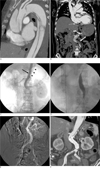Abstract
Here we report a case of infrarenal abdominal aortic occlusion secondary to Stanford type A acute aortic dissection, which was successfully treated with percutaneous fenestration and aortic stent placement. Adequate flow to the occluded infrarenal abdominal aorta was not restored by means of percutaneous fenestration alone, so an additional procedure, aortic stent placement, was required to buttress the true lumen and fenestra. We discuss ischemic complications of aortic dissection and related percutaneous intervention and review the literature.
Figures and Tables
Fig. 1
A 61-year-old female with aortic dissection (Stanford type A).
A. Sagittal maximal intensity projection (MIP) scan with contrast enhancement shows dissection flap involving ascending and descending thoracic aorta (Stanford type A).
B. Coronal scan with contrast enhancement shows dissection flap and non-enhanced infrarenal abdominal aorta presenting total occlusion (arrow). However, small enhancing mesenteric vessels are seen.
C. Abdominal aortography performed from the descending thoracic aorta shows both renal arteries. Catheterizations of the true (arrow) and false (arrowheads) lumen through the right and left common femoral artery respectively are seen.
D. The fenestra at the infrarenal abdominal aorta is inflated with a 14-mm balloon catheter.
E. Occluded infrarenal abdominal aortic flow is relieved after stent (22/60-mm Wall stent, Boston Scientific, Tokyo, Japan) placement in the true lumen.
F. Coronal CT scan with contrast enhancement after intervention shows sufficent blood flow in the infrarenal abdominal aorta and both iliac arteries with well enhanced cortexes of both kidneys.

References
1. Fann JI, Miller DC. Aortic dissection. Ann Vasc Surg. 1995; 9:311–323.
2. Williams DM, Brothers TE, Messina LM. Relief of mesenteric ischemia in type III aortic dissection with percutaneous fenestration of the aortic septum. Radiology. 1990; 174:450–452.
3. Chavan A, Rosenthal H, Luthe L, Pfingsten S, Kutschka I, Easo J, et al. Percutaneous interventions for treating ischemic complications of aortic dissection. Eur Radiol. 2009; 19:488–494.
4. Hartnell GG, Gates J. Aortic fenestration: a why, when, and how-to guide. Radiographics. 2005; 25:175–189.
5. Slonim SM, Nyman U, Semba CP, Miller DC, Mitchell RS, Dake MD. Aortic dissection: percutaneous management of ischemic complications with endovascular stents and balloon fenestration. J Vasc Surg. 1996; 23:241–253.
6. Slonim SM, Miller DC, Mitchell RS, Semba CP, Razavi MK, Dake MD. Percutaneous balloon fenestration and stenting for lifethreatening ischemic complications in patients with acute aortic dissection. J Thorac Cardiovasc Surg. 1999; 117:1118–1127.
7. Barnes DM, Williams DM, Dasika NL, Patel HJ, Weder AB, Stanley JC, et al. A single-center experience treating renal malperfusion after aortic dissection with central aortic fenestration and renal artery stenting. J Vasc Surg. 2008; 47:903–911.




 PDF
PDF ePub
ePub Citation
Citation Print
Print


 XML Download
XML Download